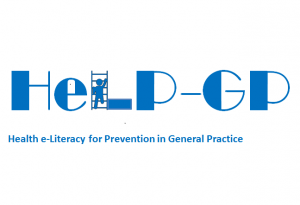Preventing chronic disease in patients with low health literacy using e-health in general practice.

Project Short Title
HeLP-GP
Project Number
NHMRC Project Grant APP1125681
Project Status
Completed
Chief Investigator
Professor Mark Harris
Additional Investigators
Professor Nigel Stocks, Professor Don Nutbeam, Professor Nick Zwar, Professor Jonathan Karnon, Professor Elizabeth Denney-Wilson, Associate Professor Margo Barr, Professor Siaw Teng-Liaw, Dr Annie Lau.
Research Team
Sharon Parker (Trial Coordinator), Katrina Baikie (RA), An Tran (RA), Shoko Saito (RA)
Rationale
The burden of chronic disease is an urgent public health priority, accounting for 90% of deaths in Australia. This is especially important for disadvantaged Australians for whom there are widening disparities in the burden of chronic diseases and their risk factors. Low health literacy (HL) affects 59% of the population and contributes directly and indirectly to these disparitie. For example low HL explains a substantial proportion of the difference in the uptake of preventive programs and self-management of chronic diseases. People with low health literacy communicate less well with health care providers, miss opportunities for prevention and suffer adverse health outcomes as a result. Providers communicate less successfully with patients with low HL, often incorrectly assuming they are not interested in an active role in their health care. To achieve better outcomes for these patients we need to adjust communication to fit patient health literacy and to take opportunities to develop HL skills. This project uses both these approaches to preventive care for patients with low HL in Australian general practice.
Aim
To evaluate the implementation and effectiveness of a preventive care intervention for obesity that is tailored to the needs of, and develops the knowledge and skills of patients with low health literacy.
To assess the delivery of this intervention within primary care.
Design and Method
Design: A cluster randomised controlled trial. Practices were randomly assigned to the HeLP GP intervention or to receive usual care provided by the GP and practice nurse.
Setting: Primary care practices in Sydney and Adelaide.
Participants:
Practice recruitment: Practices were recruited with the assistance of South Western Sydney and Adelaide Primary Health Networks (PHN’s).
Patient recruitment: Eligible patients were invited to participate on presentation to their practice. Eligible patients were those:
- Aged 40-74 years.
- Overweight or obese (BMI≥28) recorded within the previous 12 months.
- With a BP and cholesterol recorded within the previous 12 months.
- Speaking English and/or Arabic, Vietnamese or Chinese.
- With access to a smart phone or tablet device.
Exclusion criteria included:
- A diagnosis of Diabetes requiring insulin or a current prescription for insulin; a diagnosis of cardiovascular disease (angina, myocardial infarction, heart failure, heart valve disease (rheumatic or non-rheumatic), stroke (cerebrovascular accident)
- Experiencing significant recent weight loss (>5% in past 3 months) taking medication for weight loss (Orlistat or Phenteremine) or with planned weight loss surgery.
- A diagnosis of serious mental illness (schizophrenia, psychosis, bipolar depression and unipolar depression) or cognitive impairment.
- A physical impairment which would prohibit engaging in moderate level physical activity.
Intervention:
The HeLP GP intervention comprised:
- A Practice nurse led health check designed to support Australian Guidelines for the management of overweight and obesity and based on the 5A’s. Review was conducted by the PN at 6 weeks and the GP at 12 weeks.
- A lifestyle app (mysnapp).The components of mysnapp were informed by research into behaviour change through mobile and electronic platforms that suggest that goal setting and self-monitoring, and additional methods to interact with patients, particularly text messaging, can be more effective. Mysnapp allowed patients to set and revise physical activity and diet-based goals and to view graphs of their progress over the previous 6 weeks. A free text diary allowed patients to document individualised content and a range of video and written resources related to diet and physical activity were linked to the app. Text messages reminded patients to attend the follow up with the PN and GP and once registered, each patient received one nutrition and one physical activity message each week for 6 weeks.
- Health coaching via the ‘Get Healthy’ Telephone coaching program https://www.gethealthynsw.com.au/ provided free, confidential telephone-based health coaching to support participants to to reach personalised lifestyle goals relating to healthy eating, increasing physical activity, alcohol reduction and achieving and maintaining a healthy weight. Coaching was available in multiple languages with the assistance of an interpreter service.
At the health check patients could choose to take up mysnapp, Get Healthy or both. This combination intervention aimed to increase the knowledge of patients relating to diet and physical activity and their individual skills to address weight management behaviours.
Evaluation
The intervention model will be evaluated against a number of practice and patient variables including:-
- Health literacy
- eHealth literacy
- Diet and physical activity
- Weight, BMI, Blood Pressure, Lipids
- Patient recall of advice and referral
- Health-related Quality of Life.
- A health economic evaluation will also be undertaken using MBS/PBS data for consenting patients.
Ethics and consent
This trial was approved by the University of New South Wales Human Research Ethics Committee (HC17474). The University of Adelaide Human Research Ethics committee ratified this approval.
Trial Registration
This trial is registered with the Australian New Zealand Clinical Trials Registry (ACTRN 12617001508369). Date registered 30 October 2017.
Current Progress:
During 2018/2019 22 practices were recruited with 11 allocated to each group. A total of 317 patients provided consent to participate in the trial
- Baseline assessment was completed by 215 patients (120 intervention and 95 control)
- Primary analyses has been conducted and the main outcomes paper has been submitted for peer review
- We have circulated feedback to practices and patients who participated in the trial

